jon teske fragile glass handler
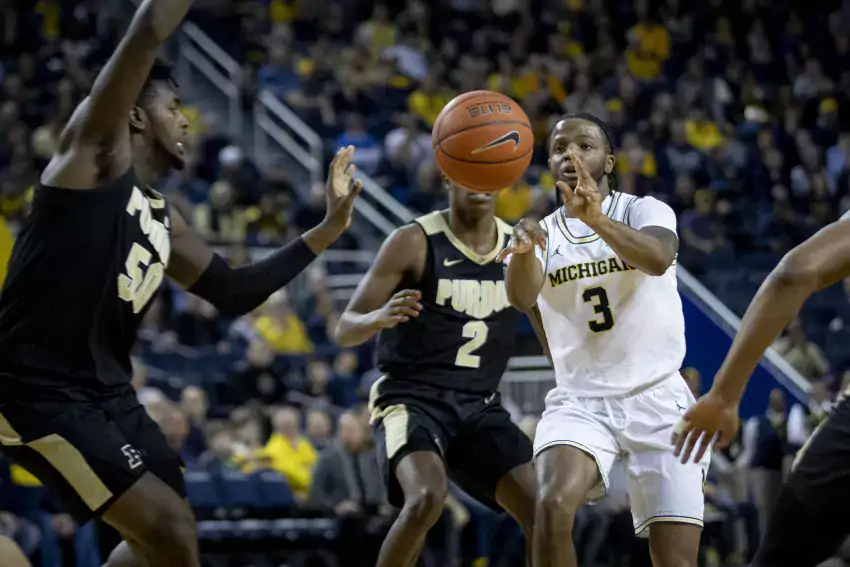
Previously: Part One, Part Two. If you're looking for the Rutgers preview it's here.
You're definitely going to want to at least read part two of this series, which explains the stats I'm using below and details the 2009-14 seasons, before moving on to the rest of this post. Ideally, you'll read part one, as well.
Now that you're caught up, let's get to it.
2014-15: Bad Wheels
Team Stats: 27.7% pick-and-rolls + passes (#36 in country), 0.911 points per play (#62)
The Ballhandlers:
| P&R Plays (Own Offense) | PPP on Own Offense (%ile) | P&R Plays (Passes) | PPP on Passes (%ile) | Total P&R Plays | Overall P&R PPP. (%ile) | Keep % | |
|---|---|---|---|---|---|---|---|
| Spike Albrecht | 65 | 0.815 (70%) | 98 | 1.276 (92%) | 178 | 1.092 (93%) | 36.5% |
| Caris LeVert | 87 | 0.644 (35%) | 58 | 0.862 (34%) | 145 | 0.731 (28%) | 60.0% |
| Derrick Walton | 52 | 0.635 (33%) | 61 | 0.967 (54%) | 113 | 0.814 (47%) | 46.0% |
| Zak Irvin | 60 | 0.783 (63%) | 43 | 1.395 (96%) | 103 | 1.039 (90%) | 58.3% |
| MAAR | 39 | 0.872 (79%) | 19 | 1.737 (100%) | 58 | 1.155 (96%) | 67.2% |
The Screeners:
| Pop Plays (%) | Pop PPP (%ile) | Roll Plays | Roll PPP (%ile) | Slip Plays (%) | Slip PPP (%ile) | Overall Plays | Overall PPP (%ile) | |
|---|---|---|---|---|---|---|---|---|
| Max Bielfeldt | 12 (36.4%) | 1.167 (88%) | 19 (57.6%) | 1.000 (30%) | 2 (6.1%) | 2.000 (—) | 33 | 1.121 (76%) |
| Ricky Doyle | 1 (3.6%) | 2.000 (—) | 26 (92.9%) | 1.308 (74%) | 1 (3.6%) | 0.000 (—) | 28 | 1.286 (90%) |
| Zak Irvin | 9 (69.2%) | 1.222 (—) | — | — | 4 (30.8%) | 2.000 (—) | 13 | 1.462 (96%) |
| Mark Donnal | 1 (10%) | 3.000 (—) | 9 (90%) | 1.556 (—) | — | — | 10 | 1.700 (99%) |
I almost didn't include this season or the next because of Michigan's injury issues, then decided it was useful to see what happens when a team's two best perimeter players get hurt in the same season.
While neither Caris LeVert nor Derrick Walton were producing particularly well in the pick-and-roll before their respective foot injuries, we saw later that these injuries delayed breakouts into effective players—Walton, in particular, eventually became a great P&R ballhandler.
The players that remained were effective but one-dimensional. Spike Albrecht drove to pass. Zak Irvin and Muhammad-Ali Abdur-Rahkman hunted shots off of screens. Irvin, defying reputation, struck the best balance between shooting and passing, and he was a very effective passer. Only MAAR was above-average at generating his own offense off of screens, though.
Derrick Walton's foot injury stunted a developing rapport with Ricky Doyle
Michigan was also working with a limited group of finishers. Ricky Doyle was the best roll man but was a roll man only. Max Bielfedlt(!) ended up with the most plays among screeners even though he was a 30th-percentile finisher on the roll; he salvaged decent efficiency with some pick-and-pop jumpers. If Zak Irvin was setting a screen, it was to pop or slip for a jump shot.
This marks the first season since 2008-09 that Michigan's pick-and-roll usage went down; they also slipped 40 spots in the efficiency rankings. This team was going to drop off with the departures of Nik Stauskas, Glenn Robinson III, and Jordan Morgan, then injuries made matters worse. Even if LeVert and Walton weren't high-level P&R ballhandlers at this point, their spot-up shooting could've helped.
Even with all that, Michigan's pick-and-roll offense ranked in the 83rd percentile by points per play. They weren't elite; they were still good. They just couldn't build the offense around it to the extent they had the previous year.
2015-16: Bad Wheels 2
Team Stats: 30.5% pick-and-rolls + passes (#22 in country), 0.923 points per play (#80)
The Ballhandlers:
| P&R Plays (Own Offense) | PPP on Own Offense (%ile) | P&R Plays (Passes) | PPP on Passes (%ile) | Total P&R Plays | Overall P&R PPP. (%ile) | Keep % | |
|---|---|---|---|---|---|---|---|
| Derrick Walton | 128 | 0.711 (44%) | 120 | 1.000 (59%) | 248 | 0.851 (51%) | 51.6% |
| Zak Irvin | 149 | 0.826 (68%) | 98 | 1.306 (93%) | 247 | 1.016 (86%) | 60.3% |
| Caris LeVert | 57 | 0.877 (77%) | 62 | 0.855 (32%) | 119 | 0.866 (54%) | 47.9% |
| MAAR | 67 | 0.910 (82%) | 41 | 0.805 (24%) | 108 | 0.870 (55%) | 62.0% |
| Duncan Robinson | 19 | 0.632 (29%) | 17 | 0.647 (9%) | 36 | 0.639 (14%) | 52.8% |
The Screeners:
| Pop Plays (%) | Pop PPP (%ile) | Roll Plays | Roll PPP (%ile) | Slip Plays (%) | Slip PPP (%ile) | Overall Plays | Overall PPP (%ile) | |
|---|---|---|---|---|---|---|---|---|
| Mark Donnal | 12 (21.8%) | 0.500 (12%) | 40 (72.7%) | 1.250 (60%) | 3 (5.5%) | 0.667 (—) | 55 | 1.055 (60%) |
| Ricky Doyle | 1 (2.9%) | 2.000 (—) | 30 (88.2%) | 1.200 (54%) | 3 (8.8%) | 0.333 (—) | 34 | 1.147 (73%) |
| Moe Wagner | 3 (15.8%) | 1.667 (—) | 16 (84.2%) | 1.375 (77%) | — | — | 19 | 1.421 (95%) |
| DJ Wilson | 9 (64.3%) | 0.556 (—) | 4 (28.6%) | 1.500 (—) | 1 (7.1%) | 0.000 (—) | 14 | 0.786 (24%) |
| Zak Irvin | 9 (81.8%) | 1.000 (—) | — | — | 2 (18.2%) | 0.000 (—) | 11 | 0.818 (27%) |
An unfortunate repeat, as Walton's previous foot injury sapped his ability to finish at the rim and LeVert—who'd improved considerably as a scorer off the high screen—again lost most of the season to a bad wheel.
Beilein increased the volume past where it had been in 2013-14 and the team's PPP slightly increased, though they came out worse compared to the rest of the country. Irvin was easily the team's best P&R ballhandler, continuing to pass at a high level while making enough pull-up jumpers to be relatively effective as a scorer.
some of those jumpers were rather important
MAAR pulled off a tough feat, averaging more PPP using his own offense than when he passed; that's very much a good news/bad news situation.
The roll men remained limited. This was the year Ricky Doyle seemingly lost the ability to catch and finish, so Mark Donnal ended up as the primary screener. Neither graded out particularly well. The center who did: enigmatic freshman Moe Wagner, who scored well as a roll man and flashed the ability to pop out and hit jumpers.
[Hit THE JUMP for Michigan exploring that a bit more.]
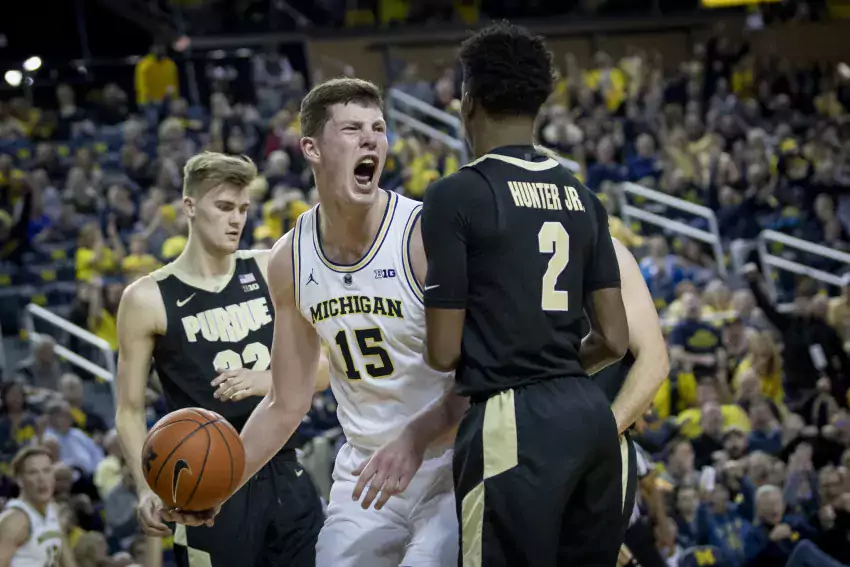
Previously: (Rather Early) Season Preview Podcast (post-Franz-injury update in last week's Ace Pod), Big Ten Tiers Part One, Big Ten Tiers Part Two, Position Preview: Definitely Guards, Position Preview: Wings
Previewpalooza tips off today with a look at the big men, the group undergoing the greatest amount of change in the transition from John Beilein, a guy who never saw a post-up he particularly liked, to Juwan Howard, a guy who literally performed hundreds upon hundreds of post-ups himself at the highest level of basketball.
Howard played power forward, and that particular position may see more of a philosophical shift than any other as it moves from wing to post. Given the team's personnel, that may very well work to their advantage. You're going to see 6'11" Colin Castleton playing alongside 7'1" Jon Teske. They're going to run some post-to-post, high-low action. They're going to put the ball on the floor with their back to the basket. They're going to block a lot of shots.
There's also Brandon Johns, perhaps the biggest wild card on a team full of them. In the minutes that Isaiah Livers isn't playing the four, Michigan's frontcourt is going to look more like a Michigan State vintage than anything the Wolverines have trotted out there—with the brief exception of Moe Wagner and DJ Wilson, if you're pushing it—in decades.
That's not to say the team is going backwards. Howard has seen first-hand how big men have evolved from Shaqs and Oakleys to Jokices and Porzingi. You're still going to see a ton of high screens, and while they may emphasize the roll a bit more, there's still going to be some pop to the perimeter. Teske and Castleton both display a level of post prowess that could translate into a decent portion of an effective offense. Even while switching the way they approach pick-and-roll defense—more on that later—they should be very good at protecting the paint.
The big men are big. They're going to play big. They're also pretty skilled. This could be fun.
#15 Jon Teske
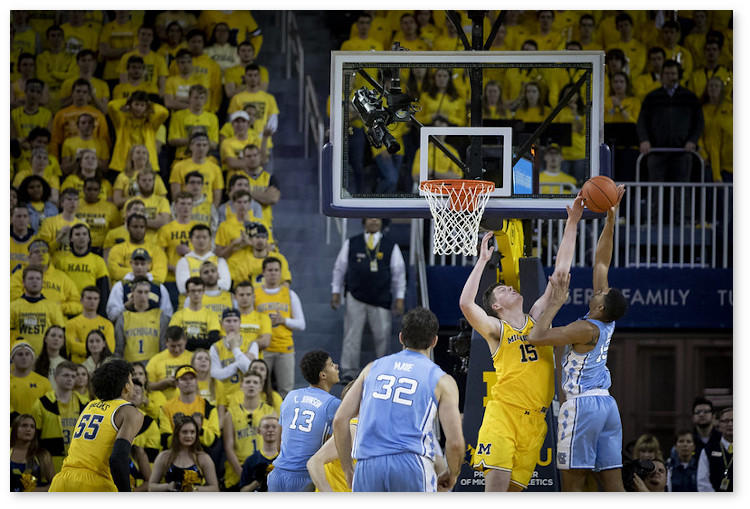 gtfo [Campredon]
gtfo [Campredon]
Year: Senior
Height/Weight: 7'1"/265
Key Counting Stats: 27.9 MPG, 9.5 PPG, 7.0 RPG, 0.9 APG, 0.7 SPG, 2.0 BPG, 61/30/59 (2P%/3P%/FT%)
Key Advanced Stats: 17.0% usage, 120.1 ORtg, 8.4 OR%, 20.2 DR%, 6.3 TORate, 34.6 FTRate, 7.4 Blk%
Both the Big Ten coaches and media left Teske off the 2018-19 all-conference third team in favor of MSU's Nick Ward, and I think we can definitively call that a mistake after Ward left for any pro opportunity that'd come calling (the Turkish Basketball League, as it turned out) to avoid sitting behind Xavier Tillman all year and Teske anchored the country's #2 defense on a team whose primary backup center was actually a 6'7" wing. Teske should've been closer to second team than honorable mention.
That's first and foremost for his defense, which is dominant beyond the two blocks per game and excellent rebounding. Remember how the offense died whenever Zavier Simpson sat on the bench? Teske's presence had the same impact on the other end—here's data against top-100 opponents from last year via Hoop Lens:
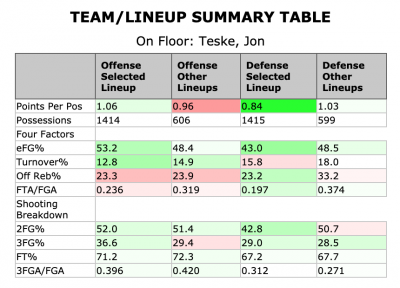
The absence of Teske's gravity as a roll man (and maybe some general three-point luck, too) knocked a tenth of a point per possession off the offense, which is by no means small, but opponents scored 0.19 more PPP on the Wolverines when Teske hit the bench—or ~13 more points over a standard 68-possession game—and the difference comes almost entirely from opponents finding both scoring and rebounding to be a lot easier on the interior.
[Hit the jump for an obscene defensive shot chart.]
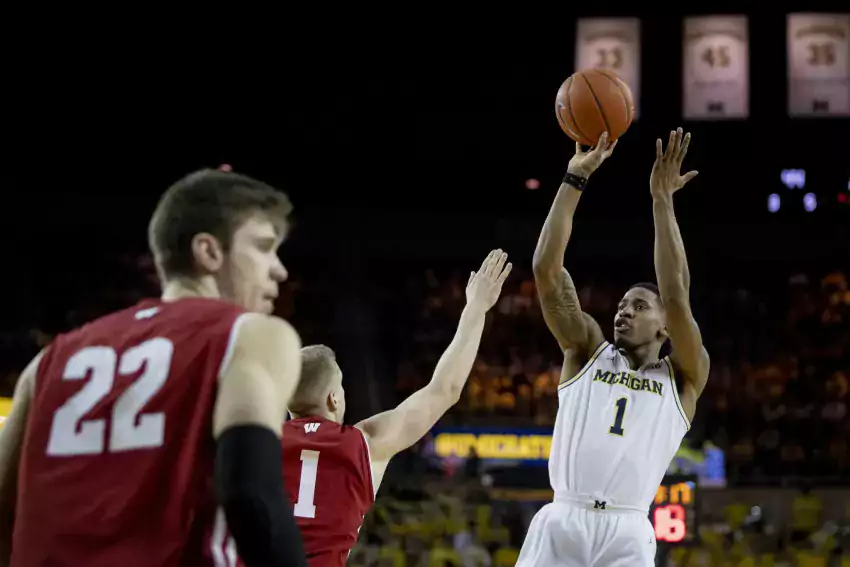
2/9/2019 – Michigan 61, Wisconsin 52 – 22-2, 11-2 Big Ten
I'm a person who looks a at lot of box scores. I look at a lot of tempo-free box scores, and a lot of bonus stats derived from play-by-play data, and then I watch the basketball. The thing that continually surprises me is just how neatly most basketball players can be defined by a deep enough dive into box score stats.
Just Shooters are just shooters. D'Mitrik Trice is a great example: he has about 10% of his shots at the rim, shoots a fair number of unassisted threes, and that is enough to paint a picture of Trice's offense exact enough to define him. In the last game the sheer loneliness of Geo Baker was neatly captured by his teammate's assist rate on his twos: under 5%. Ethan Happ, surely one of the most bizarre players in the last 20 years of college basketball, is a butterfly pinned to a board once tempo-free stats are applied.
Most of it is in there. Stats don't capture Simpson's sky hook or Charles Matthews's colossal leaping fadeaways, but they'll tell you the what and a lot of the how.
Charles Matthews's "what" has been wut:
I probably don't need to remind anyone reading this column of the above, specifically the bit that says 27%. It was 24% before this game.
The dissolution of Matthews's despair came gradually—he had two points in the first half—and then all at once. A second-half Matthews post-up got him to the rim, and hooray. The next possession, Matthews post up, Matthews elects to take a contested fadeaway baseline jumper. I did not think that was going in. It did. I didn't think the next one was going in, either. It did. So did the next one, and by the end of the game there was only one person who was going to take the bad-idea shot after Michigan ran the shot clock down. That, too, was a long fadeaway jumper. Swish.
Sure, what the hell. There's no reason Matthews's jumper fell apart this year so there's no reason it can't come back.
-------------------
If combined with offensive contributions from anyone else, a consistent offensive output from Matthews gets Michigan back to what they were earlier in the season, when they were able to run away and hide from good teams. At Villanova: 19 points on 16 shot equivalents, run away and hide. Vs UNC: 21 points on 16 shot equivalents, run away and hide. There have been blips and bloops since but nothing resembling his finishing stretch last year.
It's hard to square the version of Matthews Michigan has had much of the season with the guy who was banging out a string of efficient tourney performances. Last year's post-season ORTGs: 120, 108, 130, 97, 90, 97, 138, 103, 120, and then a dud in the final: 47. Matthews seemed to be rounding into the final collegiate version of himself, a guy who wasn't ever going to rack up MVP numbers but would be a consistent source of moderately efficient points that Michigan could count on and build off of.
Instead a mid-season drought Atcaman in its intensity.
Matthews has cut his turnovers down and become a functional free throw shooter at the same time so his overall efficiency has been more or less what it was a year ago. But you do want more, because when he hits one of those fadeaways where he jumps so high his head's level with the rim he's a marvel. Matthews alternates between being "Bambi on ice," as Beilein famously described him, and looking like a robot hawk designed to kill God and play basketball. Sometimes when you're on, as the man said.
If Michigan could just bottle that Matthews and mass produce it for 12 or 13 or 16 games down the stretch… but no. Probably not. Matthews is riding back-to-back reasonably efficient games against major competition for the first time all year. There will be oscillations, like there are with Poole and Brazdeikis, and Michigan will hope to ride the waves such that they're able to navigate to post-season destinations.
[After THE JUMP: Happ comes back to the pack]

2